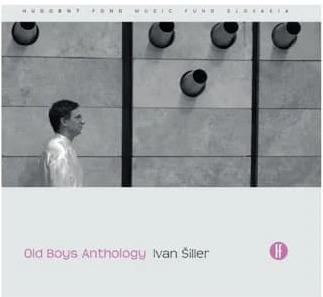For years, Mily Balakirev’s Islamey (1869) was considered the most difficult piece for piano. But contenders abound: Charles-Valentin Alkan’s Concerto for Solo Piano (published 1857)? Kaikhosru Sorabji’s Opus Clavicembalisticum (1930), Leopold Godowsky’s Studies on Chopin’s Études or György Ligeti’s Études (1985-2001)?

Juraj Beneš
To this pantheon of peril we must now add Juraj Beneš’ Suite for Piano No. 2, Old Boys Anthology (1983). This forty-minute tour de force makes extraordinary technical and interpretive demands of the pianist while offering listeners thorny yet deeply rewarding pleasures.

Ivan Šiller
Ivan Šiller’s recording for InMusic serves as an excellent introduction to Beneš’ music, which in turn opens our ears to the distinguished milieu of Slovak composers in which he grew up. Each of the ten movements of the suite honors a Slovak composer, an “old boy” from the generation preceding Beneš (1940-2004). The score identifies these composers only by initials, somewhat like Edward Elgar’s Enigma Variations, but here their full names are given. Most of the composers suffered neglect or worse following the 1968 invasion of Czechoslovakia by Russia and other Warsaw Pact countries, often due to their embrace of serialism or electronic music. Likewise, Old Boys Anthology was locked in Beneš’ publisher’s safe for years. After much delay, the late pianist Stanislav Zamborský premiered the music and later made a YouTube recording.

Šiller has said, “I’ve had this piece ‘on the piano’ for about ten years. When I first heard it performed by Stan Zamborský, I said to myself that I wanted to study it one day… It took months just to study the first part.” He describes it as a significant milestone in his own artistic development.

Miro Bázlik
The suite opens with 1. Preludium (Miro Bázlik, 1931-2024). Beneš described the movement as “a journey through the circle of fifths.” What an understatement! A kaleidoscope of keys changes every few measures, with flats and sharps alternating between hands:

As if this weren’t enough, the performer contends with constantly shifting polyrhythms and motoric passages reminiscent of Italian Baroque violin writing. While Beneš clearly knew how to write for the piano, his artistic objectives create devilish challenges. None of this difficulty is evident from Šiller’s performance, as he dispatches it all with apparent ease.
Bázlik, originally a professor of mathematics, devoted himself fully to music in his 30s. Nonetheless, he was able to play the complete solo keyboard works of Bach, Mozart and Beethoven from memory. Bázlik wrote serial music from 1961 and electroacoustic music from the early 70s with a disciplined formal language, and the Preludium reflects his formal, astringent style.
In Beneš spirit of respect for his predecessors, all of whom were superb composers, you might listen to Miro Bázlik’s Piano Concerto.

Tadeáš Salva
2. Balada (Tadeáš Salva, 1937-1995) evokes the hammered dulcimer playing this popular Slovak folk form. Salva wrote several such ballades.

Jozef Malovec
3. Impromptu (Jozef Malovec, 1933-98) begins with a Chopin-like aria for piano, which then undergoes serial transformation with references to the Alban Berg Sonata. The New Grove Dictionary of Music and Musicians’ article on Malovec almost exactly describes Beneš writing in this movement: “Malovec’s own works from this time are characterized by a synthesis of dodecaphony and tonality, while their musical processes depend upon motoric rhythms, rotation of rhythmic phrases and a tendency towards sonorous effects.” Šiller brings extraordinary lyricism to the Impromptu’s virtuosic passages. To hear to a different side of Malovec, listen to Orthogenesis (1967), the first electroacoustic music written in Slovakia.

Ivan Parik
Beneš wrote that 4. Air (Ivan Parik, 1935-2005) is a transcription, with its source Parik’s song Autumn Herd from Time of Departure. While there are a few direct correspondences, more often Beneš composes free lyrical phrases encircled by dream-like improvisations.

Ilya Zeljenka
5. Pochod / March (Ilya Zeljenka, 1932-2007) requires superb technique to bring off its dramatic leaps and reinforced octaves. Listen for the quotation of Muss es Sein? from Beethoven’s Quartet Op. 35 as well as the recitative from Beethoven’s Tempest Sonata. Zeljenka’s 1964 Structures for Orchestra exemplifies his early writing.

Juraj Hatrik
6. Reminiscensia (Juraj Hatrik, 1941-2001) alludes to Hatrik’s interest in extra-musical associations by quoting Wagner’s Prelude to Tristan and Isolde, Beethoven’s Für Elise, Debussy’s Prelude Footprints in the Snow, Bartók’s Music for Strings, Percussion and Celesta, music of Messiaen, the Berg Sonata, Debussy’s First Arabesque and Scriabin’s Vers la flamme. Since Hatrik had special interest in music for children, there’s also The Snow is Dancing from Debussy’s Children’s Corner.

Eugen Suchoň
Beneš stated that he also quoted Eugen Suchoň (1908-1993), the most famous Slovak composer from the generation before the “old boys.”

Jozef Sixta
7. Canone (Jozef Sixta, 1940-2007) mirrors Sixta’s Sólo pre klavír in a Messiaen-like meditation.

Ladislav Kupkovič
8. Berceuse / Lullaby (Ladislav Kupkovič, 1936-2016) quotes Chopin’s Berceuse before enfolding in delicate permutations, characteristic of Kupkovič’s music.
Here’s the greatest ensemble playing imaginable, in a delightful piece by Kupkovič.
Gidon Kremer & Elsbeth Moser play “Souvenir” from Ladislav Kupkovič

Peter Kolman
According to Beneš, 9. Echo (Peter Kolman, 1937-2022) begins with a quotation, possibly from Kolman’s Nota Bene. As is characteristic in Kolman’s music, silence matters as much as sound.

Roman Berger
Beneš calls the final movement from the suite, 10. Postludium (Roman Berger, 1930-2020), a passacaglia. The melody? The Blue Danube, which is similar to the beginning of Berger’s Piano Sonata No. 3 Da camera.
In an age of instant music, we risk becoming blasé to the thrill of supreme musicianship. Ivan Šiller’s recording was years in the making, and enjoying his performance takes repeated listening. That effort of engaging deeply brings profound returns. Beyond the intellectual and physical struggle that must have gone into preparing this piece, Šiller dances through Juraj Beneš’ music with exquisite phrasing, fire, balance, contemplation and athleticism. I tip my hat to his extraordinary art.
For more of the best in classical music, sign up for our E-Newsletter
